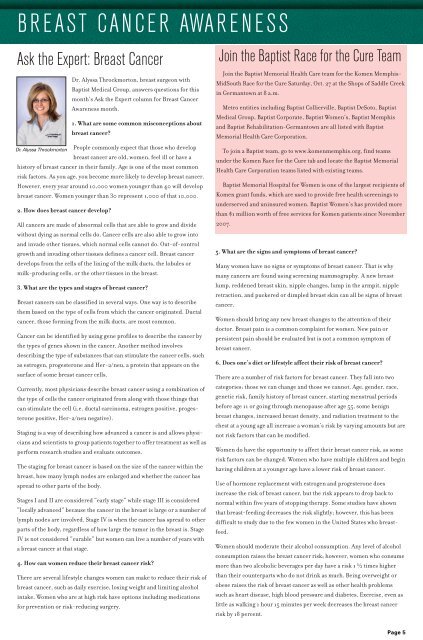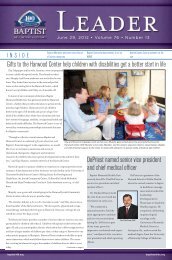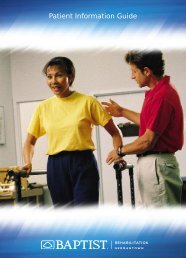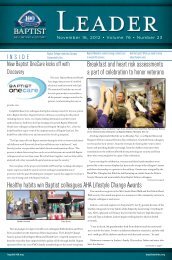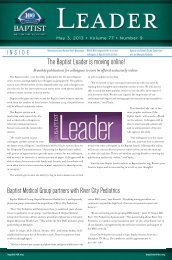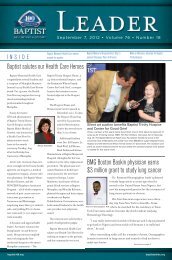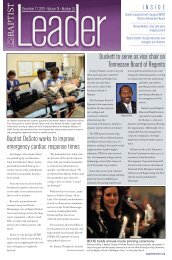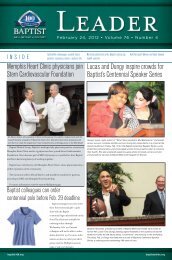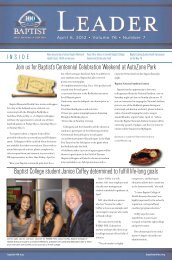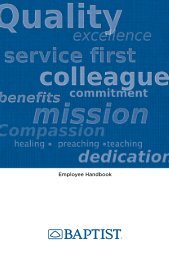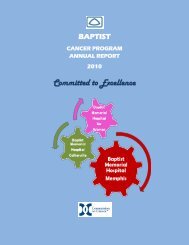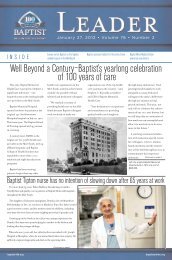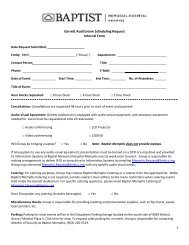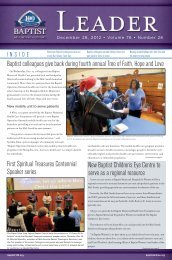October 5, 2012 - Baptist Memorial Health Care
October 5, 2012 - Baptist Memorial Health Care
October 5, 2012 - Baptist Memorial Health Care
Create successful ePaper yourself
Turn your PDF publications into a flip-book with our unique Google optimized e-Paper software.
B R E A S T C A N C E R AWA R E N E S S<br />
Ask the Expert: Breast Cancer<br />
Dr. Alyssa Throckmorton<br />
Dr. Alyssa Throckmorton, breast surgeon with<br />
<strong>Baptist</strong> Medical Group, answers questions for this<br />
month’s Ask the Expert column for Breast Cancer<br />
Awareness month.<br />
1. What are some common misconceptions about<br />
breast cancer?<br />
People commonly expect that those who develop<br />
breast cancer are old, women, feel ill or have a<br />
history of breast cancer in their family. Age is one of the most common<br />
risk factors. As you age, you become more likely to develop breast cancer.<br />
However, every year around 10,000 women younger than 40 will develop<br />
breast cancer. Women younger than 30 represent 1,000 of that 10,000.<br />
2. How does breast cancer develop?<br />
All cancers are made of abnormal cells that are able to grow and divide<br />
without dying as normal cells do. Cancer cells are also able to grow into<br />
and invade other tissues, which normal cells cannot do. Out-of-control<br />
growth and invading other tissues defines a cancer cell. Breast cancer<br />
develops from the cells of the lining of the milk ducts, the lobules or<br />
milk-producing cells, or the other tissues in the breast.<br />
3. What are the types and stages of breast cancer?<br />
Breast cancers can be classified in several ways. One way is to describe<br />
them based on the type of cells from which the cancer originated. Ductal<br />
cancer, those forming from the milk ducts, are most common.<br />
Cancer can be identified by using gene profiles to describe the cancer by<br />
the types of genes shown in the cancer. Another method involves<br />
describing the type of substances that can stimulate the cancer cells, such<br />
as estrogen, progesterone and Her-2/neu, a protein that appears on the<br />
surface of some breast cancer cells.<br />
Currently, most physicians describe breast cancer using a combination of<br />
the type of cells the cancer originated from along with those things that<br />
can stimulate the cell (i.e. ductal carcinoma, estrogen positive, progesterone<br />
positive, Her-2/neu negative).<br />
Staging is a way of describing how advanced a cancer is and allows physicians<br />
and scientists to group patients together to offer treatment as well as<br />
perform research studies and evaluate outcomes.<br />
The staging for breast cancer is based on the size of the cancer within the<br />
breast, how many lymph nodes are enlarged and whether the cancer has<br />
spread to other parts of the body.<br />
Stages I and II are considered “early stage” while stage III is considered<br />
“locally advanced” because the cancer in the breast is large or a number of<br />
lymph nodes are involved. Stage IV is when the cancer has spread to other<br />
parts of the body, regardless of how large the tumor in the breast is. Stage<br />
IV is not considered “curable” but women can live a number of years with<br />
a breast cancer at that stage.<br />
4. How can women reduce their breast cancer risk?<br />
There are several lifestyle changes women can make to reduce their risk of<br />
breast cancer, such as daily exercise, losing weight and limiting alcohol<br />
intake. Women who are at high risk have options including medications<br />
for prevention or risk-reducing surgery.<br />
Join the <strong>Baptist</strong> Race for the Cure Team<br />
Join the <strong>Baptist</strong> <strong>Memorial</strong> <strong>Health</strong> <strong>Care</strong> team for the Komen Memphis-<br />
MidSouth Race for the Cure Saturday, Oct. 27 at the Shops of Saddle Creek<br />
in Germantown at 8 a.m.<br />
Metro entities including <strong>Baptist</strong> Collierville, <strong>Baptist</strong> DeSoto, <strong>Baptist</strong><br />
Medical Group, <strong>Baptist</strong> Corporate, <strong>Baptist</strong> Women’s, <strong>Baptist</strong> Memphis<br />
and <strong>Baptist</strong> Rehabilitation-Germantown are all listed with <strong>Baptist</strong><br />
<strong>Memorial</strong> <strong>Health</strong> <strong>Care</strong> Corporation.<br />
To join a <strong>Baptist</strong> team, go to www.komenmemphis.org, find teams<br />
under the Komen Race for the Cure tab and locate the <strong>Baptist</strong> <strong>Memorial</strong><br />
<strong>Health</strong> <strong>Care</strong> Corporation teams listed with existing teams.<br />
<strong>Baptist</strong> <strong>Memorial</strong> Hospital for Women is one of the largest recipients of<br />
Komen grant funds, which are used to provide free health screenings to<br />
underserved and uninsured women. <strong>Baptist</strong> Women’s has provided more<br />
than $1 million worth of free services for Komen patients since November<br />
2007.<br />
5. What are the signs and symptoms of breast cancer?<br />
Many women have no signs or symptoms of breast cancer. That is why<br />
many cancers are found using screening mammography. A new breast<br />
lump, reddened breast skin, nipple changes, lump in the armpit, nipple<br />
retraction, and puckered or dimpled breast skin can all be signs of breast<br />
cancer.<br />
Women should bring any new breast changes to the attention of their<br />
doctor. Breast pain is a common complaint for women. New pain or<br />
persistent pain should be evaluated but is not a common symptom of<br />
breast cancer.<br />
6. Does one’s diet or lifestyle affect their risk of breast cancer?<br />
There are a number of risk factors for breast cancer. They fall into two<br />
categories: those we can change and those we cannot. Age, gender, race,<br />
genetic risk, family history of breast cancer, starting menstrual periods<br />
before age 11 or going through menopause after age 55, some benign<br />
breast changes, increased breast density, and radiation treatment to the<br />
chest at a young age all increase a woman’s risk by varying amounts but are<br />
not risk factors that can be modified.<br />
Women do have the opportunity to affect their breast cancer risk, as some<br />
risk factors can be changed. Women who have multiple children and begin<br />
having children at a younger age have a lower risk of breast cancer.<br />
Use of hormone replacement with estrogen and progesterone does<br />
increase the risk of breast cancer, but the risk appears to drop back to<br />
normal within five years of stopping therapy. Some studies have shown<br />
that breast-feeding decreases the risk slightly; however, this has been<br />
difficult to study due to the few women in the United States who breastfeed.<br />
Women should moderate their alcohol consumption. Any level of alcohol<br />
consumption raises the breast cancer risk; however, women who consume<br />
more than two alcoholic beverages per day have a risk 1 ½ times higher<br />
than their counterparts who do not drink as much. Being overweight or<br />
obese raises the risk of breast cancer as well as other health problems<br />
such as heart disease, high blood pressure and diabetes. Exercise, even as<br />
little as walking 1 hour 15 minutes per week decreases the breast cancer<br />
risk by 18 percent.<br />
Page 5


